Wartime Heritage
ASSOCIATION


copyright © Wartime Heritage Association
Website hosting courtesy of Register.com - a web.com company
Remembering
James Dunbar Devey
Jim had been at HMS Waxwing, a shore base on the Clyde, for eight days, between
December 13, 1944 and December 20, 1944, awaiting passage to Canada. On December 21,
he transferred to the RMS Queen Mary at Gourock, Scotland for a five and a half days
crossing to New York. He found himself among, not only Royal Navy personnel, Telegraphist
Air Gunners recruits departing England for training in Canada, but also some 3000 wounded
American soldiers returning home. Unlike the Royal Navy TAG recruits, Jim was not new to
the war.
The Queen Mary was escorted from the Clyde by two destroyers and with winter
weather, headed south to find a calmer crossing, an attempt to make the passage best for
the many wounded on board. Jim was billeted in the cocktail lounge, a huge room where
bunks were bolted to the floor and five high. While the ship could carry some 16,000 men,
on this crossing the number was only some 3000 military personnel.
At dawn and dusk was the greatest danger from U-boats and the ship travelled at full
speed. The average speed of this crossing would be 26 knots. Further south the weather
was still very bad and the ship crashed through huge seas with the bow rising out of the sea
and then crashing back in again, uncomfortable for all aboard.
The Royal Navy personnel took watches as lookouts and on the anti-aircraft batteries.
Off the Azores, a four engine plane was spotted and the ack ack guns were on actions
stations. It was thought the plane was a long range German reconnaissance plane, but was
finally identified as a American Liberator.
On Christmas morning, 1944, by this time beyond the mid-point of the Atlantic, Jim had rolled oats, grilled American bacon, boiled
eggs, bread, butter, preserves and coffee for breakfast.
RMS Queen Mary arrived in New York the day after Christmas. As the men of the Fleet Air Arm disembarked to a temperature of 19
degrees below zero they transferred to Hoboken Station where they were served hot drinks before heading north by train to Canada.
James arrived at HMS Seaborn (Moncton) on December 30, 1944 and continued on to Yarmouth by train arriving January 6, 1945.
At twenty three years of age, he had already experienced six long years of World War II in military service. With the Fleet Air Arm,
Royal Navy, since March 1941, he had achieved the ranks of Naval Airman, Acting Leading Airman, and Temporary Acting Petty Officer.
Earlier, with war looming, he enlisted on April 4, 1939 and served in the 125th Field Ambulance, Royal Army Medical Corps., Territorial
Army.
Born September 7, 1921, in early 1939 Jim was 17. “He cycled miles, rambled
around the countryside, passed exams, quarrelled and made up with his girlfriend, Irene,
had fun with friends, went to parties and celebrations, saw Royal visitors, was severely
ill, travelled up and down the country and had a letter about his Baltic trip published in
the Daily Express”.
Going to the movies was a main pursuit wherever he was, often with someone, but
sometimes on his own. That year he would see some 90 films including “The Trail of the
Lonesome Pine”, “The Adventures of Marco Polo”, “Test Pilot”, “Dead Men Tell No Tales”
and “Trouble Brewing”. As was the case in those days, they were often a double feature –
showing two films one after the other.
His main form of transport was a bicycle which he also used for recreation, cycling
many miles for pleasure and often keeping count of the miles he travelled long distances
by bike. He cycled to see his girlfriend, to his college at Stockport, and to see relatives.
Chess, table tennis at the Penrose League Social Club in Cheadle and rowing on
Heaton Park Lake were past times with friends.
Jim attended Stockport College and lived with his widowed father, Henry Sydney
Devey. They listened to radio programmes or had a quiet night where they spent the
evenings together. Jim’s academic interest was in the field of chemistry and he had at the
age of 15 published an article on food contamination in aerial warfare.
With war looming Jim enlisted in the 125 Field Ambulance RAMC Territorial Army on
April 4, 1939. Having passed the medical he was sworn in and attended lectures at the
RAMC Drill Hall, Upper Chorlton Road.
On May 27, he went to a training camp at Gower (Gower Peninsular) near Swansea in
Wales for 15 days. It was also in May, 1939 that he decided to join the RAF and on July 10, 1939 he was interviewed by the Air Ministry
where he passed the medical to be an ‘Observer’.
On June 16, 1939 Jim finished his chemistry subjects and returned to work at The Shirley Institute on July 24, 1939 after
completing his training with the Field Ambulance.
The Shirley Institute was established in 1920 as the British Cotton Industry Research Association at The Towers in Didsbury,
Manchester as a research centre dedicated to cotton production technologies.
When Germany invaded Poland on September 1 the Territorial Army was called up and Jim reported to Royal Army Medical Corps.
HQ in full kit at Upper Chorlton Road. He was now “on active duty”. His Service Number was 7347521 125 Field Ambulance, Royal Army
Medical Corps. His life was now taken up with drills, duty, parades and training with 2 hours on and 2 hours off. Jim, to young to go
abroad with his unit, was given clerical duties. He also began taking French classes. On December 14, 1939, Jim passed Nursing Orderly
Class 111. His duties included being out with the Medical Officer and bringing back patients from ‘sites’ each day.
As 1939 drew to a close, Jim had an eight day leave and after getting a warrant, a pass, and ration money he left by train for
Manchester. On the last night of 1939 he was asked by two girls to go to their house where he had a great “Hogmanay” (a Scottish New
Year’s celebration that lasts through the night until the morning of New Year's Day). He woke up with a ‘terrible hangover which lasted
all day’.
It was a Thursday, January 4, 1940 when Jim met Mary Caldwell at the Fountains, Alexandria. They went to see the film, ‘The
Company and the Lady’ at the Strand.
Shortly after Jim fell ill, along with many others, with bronchial influenza and tonsillitis. After days in hospital he went back to
work and began treating many patients. However, fifteen days later he was taken to Gairloch Emergency Hospital with bronchial
pneumonia and treated successfully. After 11 days Jim was somewhat better; however, two weeks later, on 13th February, he came down
with scarlet fever and was taken to Belvedere Fever Hospital in Glasgow. He was discharged one month later followed by two weeks leave
which he spent at home. He went to the movies, saw his girlfriend, Irene, and went to the Shirley Institute where he met old friends.
Just before his leave was up he was taken to Nell Lane Hospital with acute bronchitis and granted additional sick leave.
On April 8, 1940 Jim took the train to Glasgow, and on to Alexandria. He was given light duties that included giving inoculations. His
service with the Medical Corps. soon consisted of time spent travelling and giving anti-tetanus inoculations and medical examination of
men.
Jim once again dated Mary Caldwell. “Unfortunately Mary and I decided not to see each other again in case we should grow too
fond of one another!” However, that decision soon dissolved and Mary and Jim would continue to spend evenings together.
That April, Jim’s application for a laboratory post in a military hospital at S.M.O. 52 Brigade, Edinburgh was sent and once again Jim
wrote to the Air Ministry regarding a transfer.
In May, Jim was granted seven days leave and returned to his home in Manchester. He spent his leave with his father and Irene. In
June, on a date with Mary, Jim told her about Irene and once again they decided not to see each other again. Jim had known Irene for
two years and considered them the happiest two years of his life. That June, he received a parcel from her and a letter in which she
expresses her wish to get engaged.
June 16th was Sports Day and visitors were allowed so Mary came in afternoon and she and Jim “had a great time”. He gave her a
photo of himself. They met again that evening and went for a walk to Stoneymollen Road that follows a well-used route over the hills
linking the Firth of Clyde with Loch Lomondside. “However under the circumstances we have decided that we definitely will not continue
our association and I’ll get engaged to Irene”.
The war news was growing extremely grave. France had capitulated, and there were more bombing raids on Great Britain. With a
twenty-four hour leave, Jim went to Manchester and saw Irene. “We are to be engaged when I get the ring for her. Wonderful evening”.
Returning to duty in Scotland, Jim experienced his first air raid alarm and spent the day preparing equipment for air raids. An air raid just
before midnight forced him to sleep in his clothes all night. “Three enemy planes were brought down”.
With three hours of notice on July 5, Jim joined the 13th Company R.A.M.C. at Edinburgh Castle for training as a laboratory
assistant. The following day, Jim was told he would be required in a few weeks for a three months course for laboratory technician. In
the meantime he was assigned to ‘Emergency and Advance First Aid Parties’ as a night orderly caring for injured RAF officers, preparing
patients for operations, post-surgery care, and general ward duties. He also had opportunities to view operations.
Jim was very intelligent, and probably far more so than the average young man at the time. He took what and how he did things
very seriously with high expectations of others and especially of himself. Jim drove himself to the point of physical exhaustion and
illness. On July 19th, Jim was admitted to hospital. He would not be discharged until October 18, 1940. He returned home to
Manchester and was officially discharged from the Army on November 3. That same day, he went to the Town Hall and received a civilian
ration book and the identification Card No. NTA 559560. During November and December Jim spent time with family and Irene.
In early January 1941 Jim wrote to the Shirley Institute to see if he could get his old job back and was told on January 9, that that
he could return as a lab assistant.
He soon becomes accustomed to things and did regular night time fire watching duty at the Shirley Institute. He attended
Stockport College some afternoons where he registered for Inter. BSc course. Life centred on evenings with Irene, often at the movies,
fire watching, attending college and working at the Shirley Institute.
On January 25, Jim wrote for a job at Imperial Chemical Industries and went for interviews in early February.
Following a successful medical on March 18, 1941, Jim volunteered for Fleet Air Arm. Jim saw Irene nearly every day and they
walked and went to the pictures and stayed with each other, but on Irene’s 21st birthday, March 24, Jim and Irene had a row. “She
returned my ring and said she didn’t want to see me any-more”.
Two days later, Jim wrote to Mary Caldwell asking her if she would become engaged to him. On April 5, Jim received a letter from
Mary. “she consents to my proposal! ... Am I happy!”
Jim did receive a letter from Irene but did not reply or see her. Meanwhile, Mary wired to say she could put him up at a friend’s
house and on April 10, he took the 11 pm train for Glasgow. That same day he saw Irene and there was, in his words a “terrible scene”.
Jim arrived in Glasgow at 9:15 am the next morning and went straight to see Mary. They spent the days together and this continued
over the Easter holidays, going for afternoon and evening walks, having lunch together, and going to the pictures. Jim felt bad when Mary
had to leave him at Glasgow station and he caught the 11.05 pm train for Manchester after a perfect holiday.
He returned to the Shirley Institute, went out with friends in the evening, wrote to Mary and together they planned their
engagement. Jim did see Irene one more time. “Will definitely never see Irene again. Foolish Heart!”
Movies, Stockport College, letters to and from Mary, being out with friends, air raids, and fire watching became routine.
Jim received a letter from Fleet Air Arm advising the need for a medical exam in due course but it is Mary that consumes his life
and interest. She arrives from Scotland on May 31 and Jim meets her at Victoria Station. “At last we are together again”
On June 4, they both return to Glasgow. Due back at work at the Shirley Institute on June 9, Jim returns to Manchester. Jim
received a letter from the Fleet Air Arm, Royal Navy, June 19, advising him to report at Gosport for medical examination and interview on
July 1. A railway warrant was enclosed.
He went before the Selection Board for the Fleet Air Arm but failed to get through. Only two of fifteen applicants were accepted for
pilot. He volunteered for the Royal Navy and was advised he would be called up in a month’s time. He left Portsmouth at 3.20 pm and
caught train for Manchester arriving home at 2:30 am. His father approved of his decision to join the Royal Navy.
Jim was now back at Stockport College, fire watching, going to the pictures, writing exams, and writing letters to Mary. In mid-July
he again travelled to Glasgow to spend time with Mary and her family. Back in Manchester, on August 13, Jim received calling up papers
from Portsmouth to report there on Wednesday, August 20. He arranged his departure with the Shirley Institute, telegraphed the news to
Mary and arranged travel to Scotland for a visit with her.
Jim returned to Manchester for one day before leaving for Gosport, via London and Portsmouth to join the Royal Navy. He left
Stockport at 10.00 am arrived at New Barracks Gosport at 5.00 pm.
At HMS Victory, Jim received a 1st inoculation TAB, had a medical exam, an interview with Lieutenant Owen and volunteered for Air
Gunner. He passed the Air Gunner’s medical exam and was rated as Naval Airman 11 Class (Air Gunner) Fleet air Arm. FX89627. He
received his kit, identity discs and service respirator and was measured for a uniform. He commenced a six week disciplinary course.
On September 7, 1941, Jim celebrated his 20th birthday. A long weekend leave in late September is spent in Glasgow with Mary
and her family. With first training completed, Jim is drafted to HMS St Vincent, Gosport on October 10. On November 11 he is accepted
by the Selection Board for observer duties. He passed the pilot/observer medical exam. A.1. He was to finish the Air Gunner’s course in
the next eight weeks and then wait until January 12 for the Observer’s course to start.
His plan was that he and Mary would be engaged at Christmas and he arranged an engagement notice in the Lennox Herald,
Dunbartonshire. Nothing ever seemed to go as planned. In mid-December Jim was assigned Duty Watch but didn’t complete that
assignment. He went out with friends only to find himself up before the Commodore. On December 16, his 28 days leave was stopped
and he lost two days of pay and received ten additional days (No. 11 Punishment). His life in December now consisted of Duty Watch and
work in the Air Gunner’s Officer as a typist.
On Christmas Day he received a telegram from Mary .
He still had one more day of his No.11 Punishment. On
December 27, he left the barracks at 12:00 pm and caught
the train for London and on to Glasgow arriving the following
day in the early morning. Between December 28 and January
6, 1942, Jim and Mary spent the time together, shopping,
seeing films, and spending time with family.
Jim returned to HMS ‘St Vincent’ at 11:00 am after an
absence of 10 days. The leave had not been officially
approved and once again Jim found himself Up before Cdr
Handley and sentenced to 28 days imprisonment in lieu of
detention. He spent that night in the Royal Navy Barrack
cells and the following day, January 10, taken to HM Prison
Winchester to serve his 28 days. “Here beginneth the
blackest period of my life ...”
Discharged on Thursday, February 5, he returned to HMS St Vincent where he began the last four weeks of his air gunner’s course.
He was made a class leader of the special ‘Raleigh’ class. Then, two days later, on the evening of February 7, he reported to Sick Bay
where he remained until he returned to training on February 12.
On March 2, Jim received a gold signet ring from Mary to mark their engagement. He wrote his course exams on March 2 and 4:
Maths 100% Mag. & Elec’ 80%. Buzzer exam 99%. Having passed successfully, on March 7, Jim was in charge of the draft for Worthy Down.
They arrived at the Royal Naval Air Station, Worthy Down, North Winchester about 11.00 am. and joined Course 35.
On March 13, Jim suffered terrific pain in his chest and was taken to the Royal Hampshire County Hospital, Winchester where he
was admitted for pneumonia. In hospital until March 24 he was allowed up on the 21st for the first time and allowed outside for the first
time on March 23. Jim received a telegraph from Mary the day he was discharged advising that she would be going to Birmingham for ROF
(Royal Ordnance Factories) work. Jim was given 14 days sick leave and 7 days special leave and on March 25, he travelled home to visit
with his father. Mary sent him a telegraph with her address. The next day, Jim went by train to Stoke and then via Newcastle to Mary’s
billet. After being apart for three months they spent the evening together, and went to see “Hold Back the Dawn”. They returned to
Newcastle, had dinner and then Jim returned to Stockport. Mary visited the following weekend arriving on Saturday for the Easter
weekend. On Easter Monday, Jim returned with Mary to Newcastle and stayed for a few days before returning to Stockport. Mary spent
the following weekend in Stockport and together they saw more films and spent time at home. On Monday April 13, Mary left for
Newcastle. This was their “‘Cheerio’ until ... next leave! It had been a wonderful leave with Mary.”
Jim’s leave finished on April 14, and he caught the train for London arriving in the early afternoon. He booked a room at Union
Jack Club, saw “Johnny Eager” at the Empire Theatre, Leicester Square and palled up with a Canadian soldier and had a good evening.
The next day Jim arrived at HMS Kestrel at 11:00 am. On Monday he was
required to have yet another medical and then started Part 1 No 36 Air Gunners.
Instructions, lectures, exercises, and exams consumed the following days. During
the following four months, there were weekends with Mary, letters back and
forth, and plans for the wedding.
On Sunday, August 16, 1942 Jim once again took the train to Glasgow and
on to Jamestown to meet Mary. The following day, Jim and Mary were married
at 3:00 pm in the Jamestown Parish Church by Rev. C. R. Munro. The ceremony
was private with just their family present. A reception followed in the Church
Hall and they then left for Troon where they spent their honeymoon until August
25 when Jim returned to training. In early September the two managed another
weekend together.
Training continued until the end of October. During the fall months Jim
was training in aircraft when weather permitted, flying in the mornings and
attending lectures in the afternoon. On September 8 he was in a Lysander
aircraft and flew at 11,000 feet, and clocked 280 mph in a dive. Mid-September
saw the start of a Close Combat Course and a forced landed at Detling RAF drome
near Croydon. The plane run out of fuel in “terrible weather”.
By the end of October, Jim had completed a total of some 73 hours of
flying time at Worthy Down and successfully completed his examinations.
Twenty-seven members of 36 Course left Worthy Downs and travelled to Padstow
and ‘HMS Vulture’ R.N.A.S. St Merryn, Cornwall. St Merryn (HMS Vulture) was
opened in the summer of 1940 and developed into a training base for aircraft carrier fighters. Training involved air-to-air, air-to-sea and
air-to-ground gunnery practice for observers and telegraphist air gunners. The course lasted approximately five weeks. In early
December the group returned to Worthy Down and remained for “two weeks secret course”.
Jim would have 10 days leave on December 21, 1942. In the days prior Jim had several meetings. One was with Lt. Cdr. Manley
regarding earlier conduct violations. “I’ll have to prove myself in action to wipe out conduct sheet blots!”. A second meeting was an
interview at Knowle Hospital in Portsmouth with a specialist regarding his discharge from Army.
Jim travelled to Stockport where Mary met him at the station. The following day they spent shopping. On December 23, 1942 Jim
and Mary took the train to Glasgow. On Christmas Day Mary became ill and on December 28 was admitted to hospital critically ill with
pneumonia. Jim managed to obtain an extension of his leave. It was several days before Mary began to improve and by New Year’s
seemed much better. It was “a very black New Years without my darling wife Mary”. On January 2, Mary became ill again due to the
medicine, but was out of danger. Jim had to depart Glasgow on Sunday, January 3 to return to Worthy Down for Monday. On January 5,
Jim and five others left Worthy Down and arrived at Lee-On-Solent where they were drafted to HMS Waxwing to await passage to
Alexandria, Egypt. Jim was granted a 24 hour leave and did see Mary the day
she left hospital on January 15, 1943. The two had now been married five
months.
Jim was now officially assigned to 775 Naval Air Squadron, Alexandria,
Egypt, a Naval Air Squadron of the Royal Navy's Fleet Air Arm. On January 18,
HMT Stratheden sailed down the Clyde from Glasgow. Jim was billeted on E
deck. “very comfortable quarters … very good food, unlimited chocolate,
cigarettes, etc.”. The ship was 23,000 tons with a maximum speed of 23 knots.
Boat drills and lectures occupied most of the days. On February 4, they began to
wear tropical gear. The convoy, including HMT Stratheden anchored off
Freetown, Sierra Leone (West Africa), but there was no shore leave. The ship
departed Freetown on Tuesday, February 9. Jim did spend one or two hours
trying to teach a Dutch sailor English and attempting to learn Dutch and the
same time.
Arriving in Durban, South Africa on February 25, Jim disembarked on the 26th and after a shore leave departed, and an opportunity
to wire Mary, embarked on HMT City of Paris. “ … a steam ship, not so hot but I guess it will have to do.” The ship sailed as part of a
convoy on March 1. That night Jim slept on deck. On March 2 Jim, “and another bloke” was admitted to the isolation ward with scabies.
“… rather cozy …. just the two of us and more comfortable …” Two more patient arrived in isolation on March 4 and another on March 5.
“Seems to be an outbreak of scabies on this ship!” On March 11, half the convoy split off to India and on the 15 the convoy anchored off
Steamer Point, Aden. The following morning the HMT City of Paris sailed from Aden alone. “Quite strange not to be in convoy”
The ship arrived at Suez on March 20 and Jim sent another cable to Mary. On March 22 the group departed Suez by train to
Alexandria via Cairo where they had a few hours to roam around the station. Arriving at Alexandria at 5:30 am they proceeded to HMS
Grebe, Royal Navy Air Station, Dekheila. Billeted in tent 18 initially, Jim reported sick once again and was sent to 8th General Hospital
with scabies, eczema … “and goodness knows what! What a fine start to my foreign service!” By April 10 the skin lesions were
beginning to clear up. Jim managed to get “out to tea at the British Forces Club” and out with an ex POW. Repatriated Naval Prisoners
of War had arrived from Italy and Germany, exchanged for Italian personnel. By April 16 Jim was improving slowly and he believed he
shouldn’t be in hospital much longer. He found the “deadly monotony of hospital life difficult” and looked forward to any opportunity to
get out with a pass. However, Jim remained in hospital and the situation did not improve. He was re-assigned to HMS Daedalus on June
17 and sent to the General Royal Navy Hospital in Alexandria on June 21. He was to be returned to England by hospital ship when
possible.
On July 12, 1943, Mary gave birth to a baby daughter, Eileen Ann Woods Devey. Jim only received the cable gram with the news on
August 3. On July 24, Jim was sent to “78, neuropathie hospital” where he would remain until October 29, 1943. Neuropathy refers to
disorders of the nerves. Peripheral neuropathy and neuropathic pain often result from disease, no doubt in this case, a result of the
scabies.
Jim saw this as a good place and while he waited return to England and Worthy Down, he was eventually given a job in the kitchen,
then the Sisters’ Mess, and the Division Office. In October, he was doing some lab work, working with orderlies and patients. Throughout
he wrote letters to Mary and received cables an letters from Mary and his family. Eileen was christened on August 22 and Jim received a
cable from Mary. That same day there were rumours that “there is a batch of chaps going home again next week. Hope I’m on it.”
It was not until October 29, 1943 that Jim left the hospital at 2:45 am by bus to Ismailia where he boarded a hospital train and left
for Alexandria where he embarked on the HM Hospital Ship Amarapoora. They passed Malta on November 2 and Gibraltar on November 6.
On November 12 HMHS Amarapoora docked at Glasgow and Jim was sent to the Southern General Hospital Govan Glasglow. The following
day Mary visited. Jim was interviewed and advised he would likely be given ground duties at Lee-On-Solent the following week. On
November 15, 1943, Jim finally saw his daughter, Eileen, for the first time.
Returning to Lee-On-Solent and finally out of hospital, Jim was granted leave and on November 18th he travelled to Stockport to
visit his father and then on the 19th to Glasgow where he remained until December 1st.
In early 1944, now back on full military duty, Jim was re-assigned to HMS Daedalus until February 7, 1944 and then he was at HMS
Kestrel between February 7 and 28. Most of 1944 was spent at HMS Condor (February - December 11, 1944) first constructed as a Fleet
Air Arm base in 1938, when it was known as RNAS Arbroath (HMS Condor). It was a training base, primarily involved in the training of naval
aviators. A purpose-built 'aircraft carrier' sized landing area was constructed on the airfield and it, along with another similar facility at
nearby East Haven, Angus, HMS Peewit was used to train aircrew in deck landing operations. Throughout the war years the base was
additionally used as a rest area. Operational Squadrons from aircraft carriers would take it in turn to spend rest periods whilst their ships
were undergoing maintenance at Scottish Naval ship repair facilities.
In 1945, assigned to #1 Naval Air Gunners School at East Camp,
RCAF Station Yarmouth, Jim spent the cold winter months in Canada. On
February 3 the entire School had been assembled and the Commanding
Officer announced “that a preliminary signal had been received from
the Admiralty notifying that reduced commitments would enable the
training school to be disbanded and all naval personnel returned to the
United Kingdom”.
In February of 1945, the East Camp aircraft strength was 34
Ansons, 57 Swordfish IV, 10 Swordfish, 6 Walrus, 3 Hurricane XII and 4
Harvard IIB. March 3rd, 1945, Telegraphist Air Gunner Course 64A with
44 graduates was the last course to finish at East Camp. that reduced commitments would enable the training school to be disbanded
and all naval personnel returned to the United Kingdom”.
On March 10, the first draft of 340 men, the Telegraphist Air Gunners of Courses 65 through 71, entrained at the siding near the
Stores Building to begin the journey back to the United Kingdom.
A second draft of 541 personnel departed by train on March 18, 1945. Twelve days later, on March 30, Good Friday, all remaining
personnel were posted to West Camp and the training base was officially closed.
Jim was then assigned to HMS Seaborn (Kingston & St Eugene) until May 11, 1945. This base did flying training for Naval Airman.
With the war in Europe over May 8, 1945, Jim was assigned back to HMS Daedalus in England, May 12, 1945. Following a leave he moved
to HMS Cabbala, at Lowton near Warrington (August 7, 1945 – September 1, 1945) a training establishment for WRNS wireless telegraphy
operators, at Lowton near Warrington.
His final posting was at HMS Flycatcher until January 7, 1946. HMS Flycatcher was the
Headquarters for MONABs - Mobile Operational Naval Air Bases - a series of mobile units first
formed in 1944 to provide logistical support to the Fleet Air Arm aircraft of the Royal Navy's
British Pacific Fleet towards the end of World War II. Mobile Naval Operating Air Bases, MONABs,
were a series of mobile, self-contained units able to repair, and prepare for service, aircraft,
engines, and components as required for ships of the British Pacific Fleet. Each was initially
assembled at HMS Flycatcher (Ludham then Middle Wallop). In total, 10 MONABS were established
and one Transportable Aircraft Maintenance Yard (TAMY).
James (Jim) Dunbar Devey was released from his Military Service with the Royal Navy, Fleet
Air Arm, on January 7, 1946.
Post War Years:
In the early years following the end of World War II, Jim returned to his interest in
chemistry. In 1951 he completed his Bachelor of Science with Honours at the University of
Glasgow. In May, 1958 Jim was appointed customer service manager by Fredk. Boehm Ltd. He
took charge of the experimental kitchen at the Belvedere, Kent, Factory and was available to food
manufacturers in regard to the technical application of the firm’s products. Jim was originally a
member of the staff of the Food Research Laboratory of Unilever Ltd., and later with Chivers Ltd.
Prior to his appointment to Fredk. Bochm Ltd., he was Chief Chemist to the Preserves Division of
the Co-operative Wholesale Society.
Jim’s career in Food Technology spanned some sixty years. He was joint author of two
books as well as responsible for a number of technical papers. His love of his work resulted in an
extensive library that also included his old texts on aspects of Food Science and Technology.
Following the death of Mary in May, 1980, Jim now aged 59, moved to Australia from the
United Kingdom. There, he re-established his career as a Consultant Food Technologist. He
became a driving force behind the formation of the West Australian Branch of AIFST and served
on the Branch Committee since its formation. Jim initiated the idea of producing the Food
Industry Directory of Western Australia (1988).
James (Jim) Dunbar Devey died on
February 6, 1988 in Fremantle, Western
Australia. For those who had the good
fortune to know him, he would be
remembered as an interesting,
knowledgeable, and fascinating man to talk
to. He could be considered one of the
world’s great conversationalists. Jim loved
nothing more than to hold an audience
captive on any subject from food technology
to the arts. He was also a prolific letter
writer, corresponding with colleagues, old
friends, and casual acquaintances from
around the world. His correspondents included eminent Food Scientists and Technologists, often old personal friends, and even Heads of
State.
Three months of Jim’s life during World War II were spent in Yarmouth, Nova Scotia. It can only be assumed, as no specific records
remain, that he likely served as a wireless telegraphy Instructor at No. 1 Naval Air Gunners School. Based upon his training and
experience, and various assignments prior to his arrival in Yarmouth, he had some expertise in the area of wireless telegraphy.
His wartime experience in the years prior to his arrival in Yarmouth is known because for five years between 1939 through 1943
James Dunbar Devey kept a personal diary. We know about his experience following World War II because of his success in his food
Technology career and the memories of his family.
On January 6, 1945, James (Jim) Dunbar Devey, Temporary
Acting Petty Officer (A), entered the main gate of East Camp, No. 2
Telegraphist Air Gunner School, Royal Canadian Air Force Station
Yarmouth, the training base of the Fleet Air Arm Royal Navy in
Yarmouth, Nova Scotia. He remained on staff at East Camp until March
31, 1945.
Main Gate - East Camp WWII
Remembering James Dunbar Devey
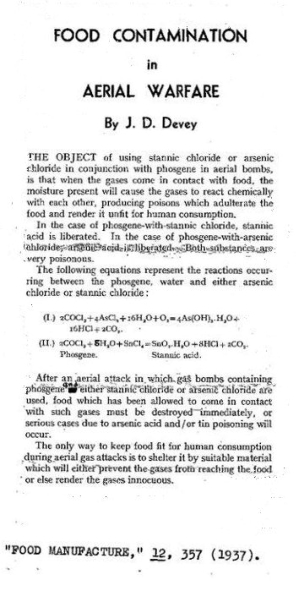
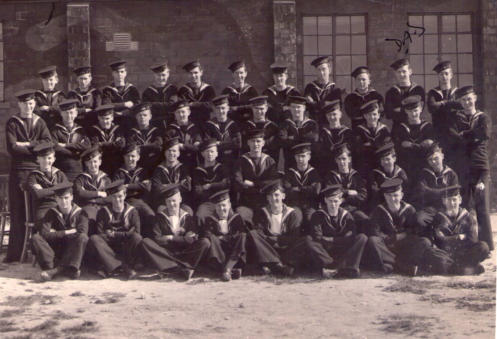
James Dunbar Devey:
HMS Seaborn (2 TAG School Yarmouth)
Temporary Acting Petty Officer (A)
06 Jan 1945 - 31 Mar 1945.
... the only official military reference to his time
spent at East Camp, Yarmouth, Nova Scotia.
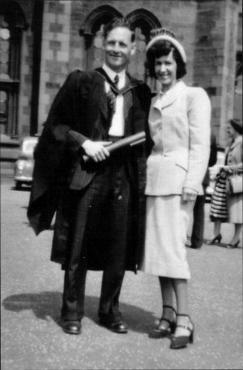
Jim and Mary had three children.
Aileen Ann Woods Johnston (her
name changed from Eileen, as
she was named at birth, due to
people's pronunciation) was born
July 12, 1943 and now lives in
Riverhead, Sevenoaks, Kent,
England. Fiona Helen Dunbar
Blake was born October 24,
1946 and lives in Busselton,
South West, Western Australia.
Philip James Dunbar Devey was
born January 23, 1952 and lives
in Worth, Crawley, West Sussex,
England.
There are six grandchildren, five
girls and one boy.
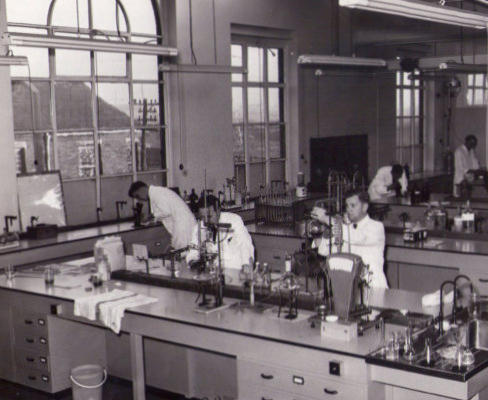
James (left on front bench)
Sources:
Fiona Blake (daughter of James Dunbar Devey) Busselton, South
West, Western Australia.
Additional Information:
http://www.sterling.rmplc.co.uk/history/wartime.html
http://www.amazon.co.uk/James-Dunbar-Devey/e/B00JTNBBC0
https://www.youtube.com/watch?v=ZzEo6WrY9ec
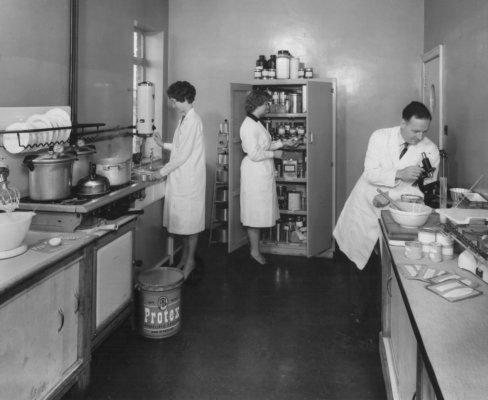
Jim (in lab coat with other personnel at Fredk. Boehm
Ltd.) Showing part of the experimental soup kitchens
operated under direction of qualified personnel
maintained by Fredk. Boehm, Ltd.
(photo was printed in the Food Trade Review -
September 1962)
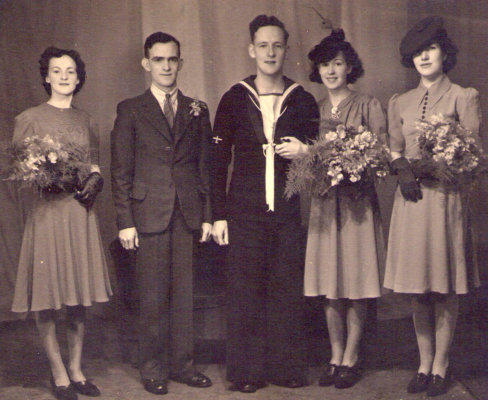
Mary and Jim’s Wedding:
August 17, 1942, 3 pm
Jamestown Parish Church, Jamestown, Scotland.
(From left: Mary's younger sister Anna, Herbert K
Caldwell Mary's older brother Jim & Mary and Mary's
best friend Chrissie Paton)
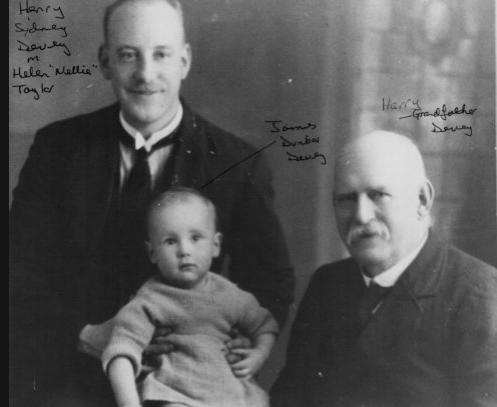
Three Generations:
(left to right) Harry Sidney, James Dunbar, and Harry
Devey
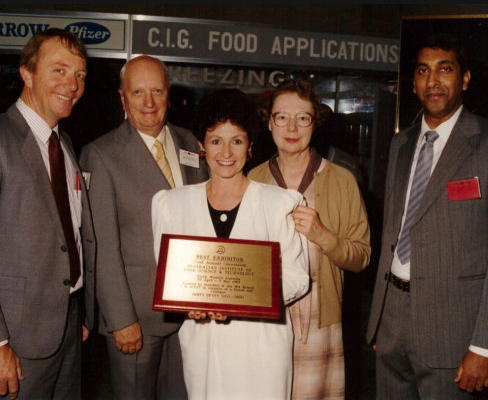
Award in memory of James Dunbar Devey by Food
Technology colleagues
(left to right: Peter Husband, Ralston Laurie, Fiona
(daughter) Jean and Chris)
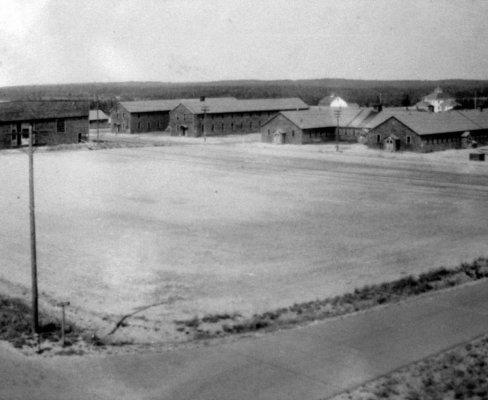
East Camp Parade Square
WWII (Yarmouth N.S. Canada)
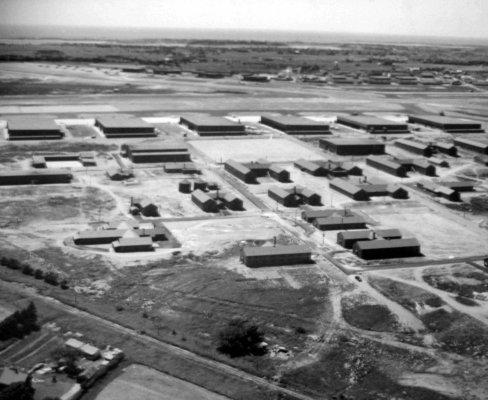
East Camp
No 2 Naval Air Gunner School
WWII (Yarmouth N.S. Canada)


- World War I - Menu
- WWI Stories and Articles
- Photos - Yarmouth Soldiers
- Selection of World War I Songs
- WWI Casualties of Yarmouth, NS
- Those Who Served - Yarmouth, NS
- WWI Casualties Digby Co. NS
- WWI Casualties Shelburne Co. NS
- Merchant Mariners (1915) Yarmouth, NS
- Canadian Forestry Corps - Non Yarmouth Birth/Residence Enlistments
- US Draft Registry - Yarmouth NS Born


- World War II - Menu
- WWII Stories and Articles
- Telegraphist Air Gunners
- WWII Casualties of Nova Scotia
- US Casualties with NS Connection
- Far East/Pacific Casualties with NS Connection
- Merchant Navy Casualties Nova Scotia
- Nova Scotia WWII Casualties Holten Canadian War Cemetery
- D-Day Casualties - Nova Scotia
- CANLOAN Program Casualties - Nova Scotia
- Battle of the Bulge Casualties - Nova Scotia
- WWII Casualties Yarmouth NS
- Yarmouth Casualties - RCAF RAF Canadian Army WWII
- Yarmouth Co., Marrages WWII
- Casualties Non-Born/Residents with Connection to Yarmouth Co., Nova Scotia.
- WWII Casualties Digby Co., NS
- Non-Nova Scotian WWII Casualties Buried in Nova Scotia
- WWII RCAF Casualties Aged 16-18
- Brothers/Sisters Who Served - World War II













